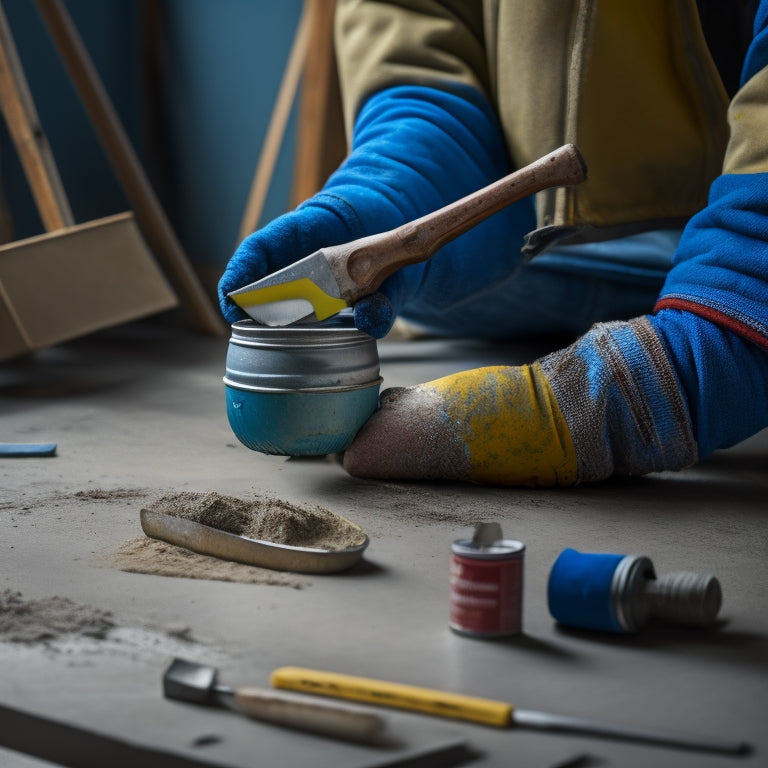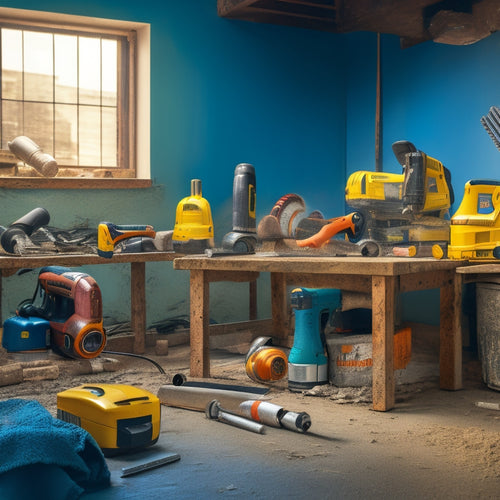
Why Remove Concrete Paint With These Top Tools
Share
You're about to begin a vital step in concrete paint removal, and that's choosing the right tools for the job. You'll want to equip yourself with powerful scraping tools, like putty knives and wire brushes, to tackle thick, dried paint. Chemical stripping methods, such as alkaline-based strippers and bio-based solvents, offer a safe and effective way to break down multiple layers. Pressure washing, sanding, and infrared heat gun techniques will help you prep the surface for new coats. By understanding the strengths of each tool, you'll be able to tackle even the toughest paint removal projects - and with the right techniques, you'll reveal a flawless finish.
Key Takeaways
• Removing old concrete paint prepares the surface for a fresh coat, ensuring a strong bond and a longer-lasting finish.
• Effective paint removal tools help prevent peeling, flaking, and blistering, maintaining the aesthetic appeal of the concrete surface.
• Top tools for concrete paint removal save time and effort, making the process more efficient and reducing labor costs.
• Using the right tools and techniques prevents damage to the concrete, reducing the risk of costly repairs and ensuring a smooth finish.
• Proper paint removal allows for a thorough cleaning and surface preparation, creating a safe and durable surface for various applications.
Powerful Scraping Tools for Removal
When tackling a concrete paint removal project, you'll need to arm yourself with powerful scraping tools that can efficiently break down and remove the old paint.
There are several scraping tool types to choose from, including putty knives, scraper blades, and wire brushes. Each type is designed for specific tasks, so it's crucial to select the right one for your project. For instance, putty knives are ideal for removing thick, dried paint, while scraper blades are better suited for scraping off thin layers. Wire brushes, on the other hand, are perfect for roughening the surface before applying a new coat.
To guarantee your scraping tools remain effective, follow these scraper maintenance tips: regularly clean and inspect your tools, replace worn-out blades, and store them in a dry place.
Effective Chemical Stripping Methods
When it comes to effective chemical stripping methods, you'll want to contemplate safe strip options that won't damage the concrete surface.
You'll also need to choose fast removal formulas that can efficiently break down the paint without leaving residue.
Safe Strip Options
You can opt for effective chemical stripping methods that prioritize safety, such as using alkaline-based strippers or bio-based solvents, to remove concrete paint without compromising your health or the environment. These eco-friendly solutions offer a safer alternative to traditional methods, ensuring a healthier stripping process.
When choosing a safe strip option, consider the following:
-
Alkaline-based strippers: These mild, non-toxic formulas are gentle on surfaces and the environment. They're ideal for removing multiple layers of paint without damaging the underlying concrete.
-
Bio-based solvents: Derived from natural sources, these solvents are biodegradable and non-toxic. They effectively break down paint without releasing harmful fumes or residues.
-
Plant-based removers: These innovative solutions utilize plant extracts to dissolve and remove paint. They're a great option for those seeking a truly green, eco-friendly approach.
Fast Removal Formulas
Fast removal formulas, such as methylene chloride-based strippers and other aggressive solvents, can rapidly dissolve and break down concrete paint, allowing for swift and efficient removal.
When using these formulas, you'll want to guarantee removal safety by wearing protective gear, including gloves, safety glasses, and a mask. Additionally, make certain the area is well-ventilated to prevent inhaling harsh fumes.
It's essential to choose a formula that's compatible with the type of paint you're removing. Incompatible formulas can damage the concrete surface or leave residues that affect future coatings. Always read the product label and follow the instructions carefully. Some formulas may require a test patch before applying it to the entire surface.
Remember to apply the formula according to the manufacturer's instructions and wait the recommended time for it to take effect. Then, use a scraper or pressure washer to remove the paint. Be cautious not to over-saturate the surface, as this can lead to further damage.
Pressure Washing for Concrete
When you're looking to remove old paint from concrete, pressure washing is a great way to start.
You'll want to use the right cleaning methods to guarantee the old paint is completely removed, and the surface is prepared for new coatings.
Wash Away Old Paint
Pressure washing is a highly effective method for removing old paint from concrete surfaces, as it blasts away stubborn paint residue with a powerful stream of water. This technique is especially useful when dealing with paint adhesion issues, where the old paint is peeling or flaking off. By using a pressure washer, you can guarantee a thorough concrete surface preparation, which is essential for a successful paint job.
Here are three key benefits of using a pressure washer to remove old paint:
-
Efficient removal: Pressure washing quickly and easily removes old paint, saving you time and effort.
-
Thorough cleaning: The powerful stream of water reaches into crevices and corners, guaranteeing a thorough cleaning of the entire surface.
-
Surface preparation: Pressure washing helps to prepare the concrete surface for new paint, guaranteeing a strong bond and reducing the risk of paint adhesion issues.
Remember to always follow safety guidelines when using a pressure washer, including wearing protective gear and maintaining a safe distance from the nozzle. By using a pressure washer, you'll be able to remove old paint quickly and efficiently, paving the way for a successful paint job.
Effective Cleaning Methods
Using the right cleaning methods is vital to removing old paint from concrete surfaces, and pressure washing is one of the most effective techniques to achieve a thorough and efficient cleanup.
When you're preparing to remove old paint, it's important to take into account environmental considerations, such as containing the wash water and preventing it from entering storm drains.
You'll also want to guarantee proper surface preparation by sweeping or blowing away any loose debris and masking off surrounding areas to prevent damage.
When pressure washing, use a wide fan tip and keep the nozzle at least 12 inches away from the surface to avoid damaging the concrete.
Work in sections, and use a low-pressure setting (around 1,000-1,500 PSI) to avoid etching the surface.
Keep the pressure washer moving in a consistent, overlapping pattern to achieve an even clean.
Remember to wear protective gear, including gloves, safety glasses, and a mask, to prevent injury from flying debris and chemical exposure.
Using Sanding Blocks Efficiently
Sanding blocks become an extension of your arm as you work to remove concrete paint, allowing you to focus on maintaining consistent contact and even strokes. This is especially significant when using sanding blocks, as they can be prone to wear and tear. To get the most out of your sanding blocks, it's crucial to master effective sanding techniques.
Here are three key tips to keep in mind:
-
Choose the right grit: Select a sanding block with the appropriate grit for your concrete paint removal project. A higher grit (80-100) is ideal for smoothing out rough surfaces, while a lower grit (40-60) is better suited for removing thick layers of paint.
-
Apply even pressure: Apply consistent pressure to the sanding block, avoiding applying too much pressure on one spot. This will help prevent uneven wear on the block and promote a smooth finish.
-
Inspect and replace regularly: Regularly inspect your sanding block for signs of wear, such as clogged pores or uneven surfaces. Replace the block when necessary to maintain maximum performance and block durability.
Infrared Heat Gun Techniques
With an infrared heat gun in hand, you're about to access a powerful tool for removing concrete paint, capable of breaking down even the toughest layers in a matter of seconds. This device utilizes infrared efficiency to generate intense heat, which you'll apply directly to the painted surface. As the heat penetrates the paint, it weakens the bond between the paint and the concrete, making removal a breeze.
When applying heat, maintain a safe distance of about 6-8 inches from the surface to avoid damaging the concrete or starting a fire. Move the gun in slow, circular motions to guarantee even heat application. Be cautious not to focus the heat on a single spot for too long, as this can cause damage.
It's also crucial to wear heat-resistant gloves and safety goggles to protect yourself from the intense heat.
As the paint begins to soften, use a scraper or putty knife to remove the loosened layers. Repeat the process as needed until the paint is completely removed.
Scraping With Putty Knives Made Easy
You'll find that scraping with putty knives becomes a surprisingly efficient process once you've loosened the paint with an infrared heat gun, as the softened layers come off easily with a few swift strokes. This is where your putty knife techniques come into play.
To maximize efficiency and safety, follow these scraping tips:
-
Hold the putty knife at a 20-30° angle, allowing the blade to scrape away the paint without digging into the concrete.
-
Apply moderate pressure, increasing or decreasing as needed based on the paint's adhesion.
-
Use long, smooth strokes, working in sections to maintain control and avoid creating uneven surfaces.
Removing Old Paint With Grinders
Removing Old Paint With Grinders
Switching to grinders, a more aggressive approach, enables you to tackle thicker, harder-to-remove paint layers. When using grinders, remember to prioritize grinder safety. Always wear protective gear, including gloves, safety glasses, and a dust mask. Confirm the grinder is designed for concrete paint removal and follow the manufacturer's instructions.
Here's a comparison of grinder types for concrete paint removal:
| Grinder Type | Advantages | Disadvantages |
|---|---|---|
| Angle Grinder | High torque, effective for thick paint layers | Heavy, difficult to maneuver |
| Die Grinder | Compact, versatile, and easy to use | Less powerful, may not remove thick layers |
| Rotary Hammer | Excellent for heavy-duty removal, high speed | Heavy, requires more skill and control |
When grinding, maintain a consistent pace and apply moderate pressure. This prevents overheating the grinder and confirms a smooth surface preparation. Keep the grinder moving to avoid creating scratches or swirl marks. Regularly clean the grinder and replace worn-out abrasives to maintain efficiency.
Safe Solvent-Based Removers
Turn to safe solvent-based removers when you need a more targeted approach to remove old paint from concrete surfaces. These removers are designed to effectively break down and dissolve paint, making it easier to scrape off.
When choosing a solvent-based remover, prioritize paint safety and environmental impact. Opt for removers that are biodegradable, non-toxic, and have low volatile organic compounds (VOCs).
Here are three key benefits of using safe solvent-based removers:
-
Targeted removal: Solvent-based removers can be applied directly to the painted area, allowing you to target specific sections without damaging surrounding concrete.
-
Effective paint breakdown: These removers can break down even the toughest paint, making it easier to remove without damaging the underlying surface.
-
Reduced environmental impact: By choosing eco-friendly removers, you can minimize the environmental impact of your paint removal project.
Remember to always follow the manufacturer's instructions and take necessary safety precautions when working with solvent-based removers. This includes wearing protective gear, such as gloves and goggles, and working in a well-ventilated area.
Frequently Asked Questions
Can I Reuse Removed Concrete Paint for Another Project?
You're wondering if you can reuse removed concrete paint for another project.
Before doing so, assess the paint's properties, such as its type, adhesion, and durability.
Consider the project's suitability, including the new surface's condition, environmental exposure, and intended use.
If the paint still meets the requirements, you can reuse it.
However, if it's degraded or incompatible, it's safer to discard it and choose a fresh, suitable paint to guarantee a successful and safe outcome.
How Do I Protect Surrounding Surfaces During Removal?
When removing concrete paint, you'll want to protect surrounding surfaces to avoid damage.
Start by applying surface shielding, such as plastic sheets or tarps, to cover adjacent areas.
Next, use masking techniques like painter's tape or masking film to create a seal around edges and corners.
Make certain these barriers are securely fastened to prevent paint and solvents from seeping underneath.
This will guarantee a safe and controlled removal process.
Are There Eco-Friendly Alternatives to Chemical Strippers?
You're torn between effectively removing concrete paint and protecting the environment.
On one hand, chemical strippers get the job done, but on the other, they harm the planet.
Fear not! You can opt for eco-friendly alternatives like biodegradable strippers or natural solvents, which are just as effective but gentler on the environment.
These alternatives will give you a clear conscience and a paint-free surface.
Can I Remove Concrete Paint in Extreme Temperatures?
When removing concrete paint, you'll need to take into account temperature effects on paint adhesion.
In extreme temperatures, whether it's scorching heat or freezing cold, the paint may become more brittle or soft, affecting its adhesion to the concrete. You'll need to adjust your removal method accordingly.
In hot temperatures, work in shaded areas or use cooling measures to prevent paint from softening.
In cold temperatures, verify the surface is dry and free of moisture to maintain ideal adhesion.
Do I Need to Wear Protective Gear During the Process?
When removing concrete paint, you'll want to prioritize your safety above all else.
Do you need to wear protective gear during the process? Absolutely! You should wear protective clothing, including long sleeves, pants, and gloves to prevent skin irritation.
Don't forget safety goggles to shield your eyes from paint particles and chemicals.
Conclusion
You've made it this far, and now you're just one step away from revealing a fresh, paint-free concrete surface.
With these top tools in your arsenal, you're ready to tackle even the toughest paint removal jobs.
But, be warned: the real challenge lies ahead.
As you plunge into the removal process, be prepared to face unexpected obstacles and surprises.
Will you emerge victorious, or will the old paint prove to be a formidable foe?
Related Posts
-

Top Concrete Resurfacing Tools for a Pro Finish
When it comes to achieving a professional finish in concrete resurfacing projects, you require the right set of speci...
-

7 Must-Have Tools for Concrete Repair Organization
To effectively organize your concrete repair projects, you'll need a thorough toolkit that includes a well-planned st...
-

Essential Power Tools for Concrete Block Construction
When building with concrete blocks, you'll need a range of power tools to cut, drill, mix, and finish the blocks to g...


